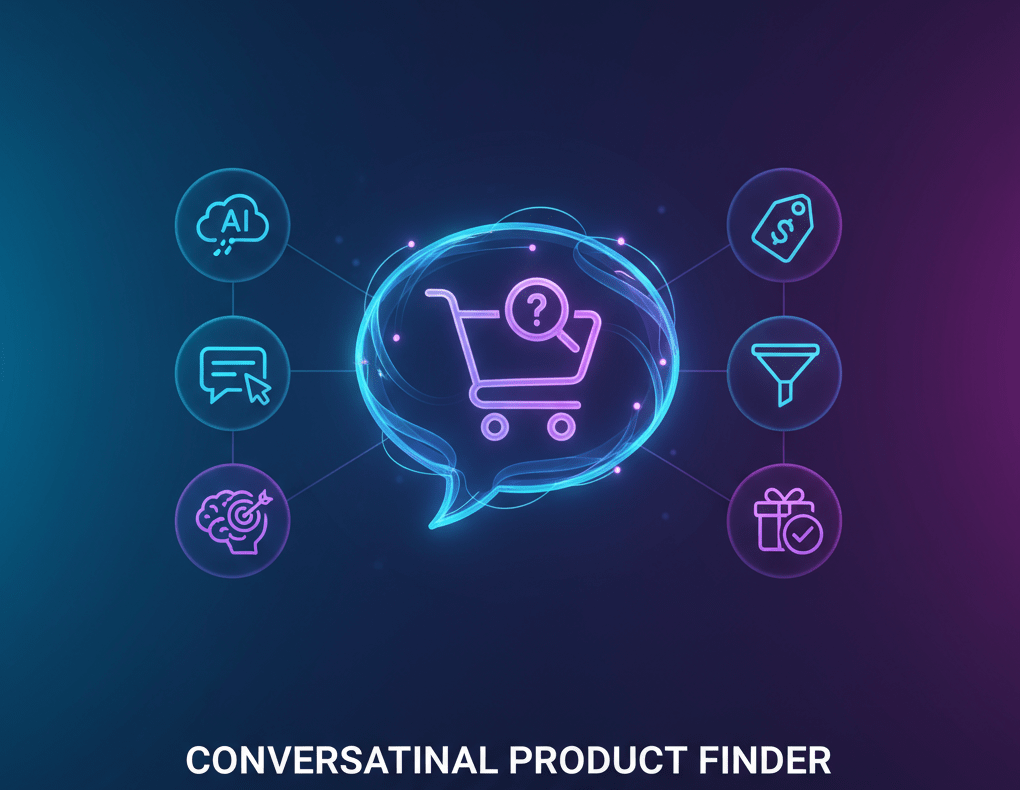“Transform your e-commerce site with a conversational product finder that utilizes AI to understand customer intent, guide them to the right products, and increase conversion rates.”
Take a moment and picture a customer landing on your online store. They have a problem to solve, a need to fulfill, or a gift to find. They arrive full of intent. And then what happens? They face the cold, silent abyss of the search bar. Or worse, a labyrinthine menu with dozens of filters and checkboxes. They scroll, they click, they get frustrated, and then… they bounce. That potential sale, that new loyal customer, vanishes in a single click of the “back” button.
This scenario plays out thousands, if not millions, of times a day across the internet. As e-commerce managers and store owners, we have invested a significant amount in beautiful website designs, high-quality product photography, and compelling ad campaigns, only to lose customers at the most critical stage: the moment of discovery. The traditional tools we rely on—static search bars and filter menus—are fundamentally broken for a vast segment of shoppers. They are relics of a bygone digital era, designed for users who already know exactly what they’re looking for.
But what about the rest? What about the customer who knows they need a new laptop but is overwhelmed by terms like “RAM,” “SSD,” and “processor cores”? Or the person desperate to find the perfect birthday gift for their notoriously picky sister? Or the homeowner trying to find the right drill bit for a specific project?
For these customers, your website isn’t a helpful store; it’s a warehouse. They are left to wander the aisles alone, without guidance, hoping to stumble upon the correct item.
Now, imagine a different experience. Imagine if, the moment that the customer landed on your site, a friendly, expert appeared. Not an annoying pop-up, but a helpful guide. It doesn’t just wait for a command; it starts a conversation.
“Hi there! Welcome. What brings you in today? Are you shopping for yourself or someone else?”
This is the promise of a conversational product finder. It’s not just another piece of tech; it’s a fundamental shift in how we approach online shopping. It’s about transforming your passive, static catalog into an active, engaging, and genuinely helpful AI shopping assistant. It is, quite simply, a better way to browse. This guide will explore why this technology is no longer a futuristic luxury but an essential tool for survival and growth in the competitive e-commerce landscape. We will break down precisely what it is, the profound impact it can have on your key metrics, and how you can implement it on your store—without needing a team of developers or a massive budget.

The Great Disconnect: Why Traditional Product Discovery Fails
Before we dive into the solution, we need to fully appreciate the problem. The tools we currently use are not just slightly inefficient; they are actively working against a large portion of our customers. They create friction, cause confusion, and ultimately kill sales.
The Tyranny of the Search Bar
The search bar is a standard feature on e-commerce sites, and it is also one of the most flawed. It operates on a simple, unforgiving principle: you get out what you put in.
If a customer knows the exact product name, model number, or SKU, the search bar works flawlessly. Entering “iPhone 15 Pro Max 256GB Blue Titanium” will direct them right where they need to go. But how often does that happen?
More often, customers search with intent, rather than specific terms. They search for solutions, not products.
- A customer types “running shoes for bad knees.” The search bar sees “running shoes” and shows them 200 different pairs, most of which are completely wrong for their needs. It ignores the crucial context: “for bad knees.”
- Someone searches “gift for dad who likes fishing.” The system might pick up “fishing” and show them a random assortment of lures and rods, completely missing the opportunity to suggest a waterproof phone case, a high-quality thermos, or polarized sunglasses.
- A user searches “dress for a summer wedding.” The results are a chaotic mix of casual sundresses, formal evening gowns, and office wear. The user is left to manually filter by color, size, style, and price, a tedious process that often leads to abandonment.
The standard search bar is a dictionary. It looks for exact keyword matches. What customers need is a translator—something that understands their intent and translates it into the perfect product. Without that translation, it’s a dead end. This is a primary driver of high bounce rates. Customers search, get irrelevant results, and leave immediately.
The Paralysis of Filter Menus
So, what’s the alternative? The dreaded sidebar filled with an endless list of filters. On the surface, filters are a good idea. They give customers control, allowing them to narrow down the options. The reality, however, is often “filter fatigue” and “decision paralysis.”
Consider a customer shopping for a new television. They are confronted with a wall of checkboxes:
- Brand: Sony, Samsung, LG, TCL, Hisense…
- Screen Size: 32″, 43″, 50″, 55″, 65″, 75″, 85″…
- Resolution: 1080p, 4K, 8K…
- Display Technology: LED, QLED, OLED, Mini-LED…
- Features: Smart TV, HDR, Dolby Vision, High Refresh Rate, Gaming Mode…
A tech enthusiast might relish these options. However, for the average person who simply wants a good TV for their living room, this can be overwhelming. They are unaware of the difference between QLED and OLED. They aren’t sure if they need Dolby Vision. Each checkbox represents a decision they feel unqualified to make.
Faced with too many choices and not enough information, they do the easiest thing: nothing. They close the tab and decide to visit a physical store, where they can ask a real person for help. Your complex filter menu, designed to be helpful, has just cost you a sale. It forces users to become experts in your product category just to make a purchase.
The Soulless, Static Catalog
The final failure point is the product grid itself. Page after page of product thumbnails, arranged by price or “newest.” It’s an interactive catalog in name only. There is nothing interactive about it. It’s a monologue, not a dialogue.
This format puts 100% of the cognitive load on the customer. They must:
- Scroll through potentially hundreds of products.
- Click on individual items to read descriptions and specs.
- Press the “Back” button to compare it with another item.
- Try to recall the features of product A while examining product C.
- Guess which product is best suited for their specific, unstated need.
This is not a shopping experience; it’s a research project. And most people don’t have the time or patience for it. This lack of guidance is a missed opportunity to tell a compelling story, explain the benefits, and connect the right product with the right person.
A New Paradigm: The Conversational Product Finder as a Guided Selling Expert
Now, let’s return to our reimagined scenario. The conversational product finder flips the entire model on its head. Instead of forcing the customer to do all the work, it takes an active role. It acts as a guided selling expert, available 24/7.
It doesn’t wait for commands. It initiates a conversation to understand the customer’s context. This is the key difference. It seeks to understand the “why” behind the visit before suggesting the “what.”
The process is intuitive, natural, and powerfully effective. It mimics the interaction a customer would have with the best salesperson in a high-end retail store.
Step 1: The Warm Welcome and Opening Question
Instead of a blank search bar, the customer is greeted with a prompt.
- For a clothing store: “Finding the perfect outfit can be tough! Let me help. What occasion are you shopping for?”
- For an electronics store: “Welcome! To help me find the right tech for you, could you tell me a bit about what you’ll be using it for?”
- For a gift shop: “Looking for the perfect gift? You’ve come to the right place! Who are we shopping for today?”
This first interaction immediately changes the dynamic. The website is no longer a passive entity. It is an active participant in the shopping journey. It shows the customer that their needs will be heard.
Step 2: The Art of Asking the Right Questions
This is where the magic happens. The AI-powered finder drills down with a series of thoughtful, targeted questions based on the customer’s initial response. It’s a dynamic process, not a rigid, pre-programmed quiz.
Let’s follow a potential conversation on a skincare website:
AI Assistant: “Hi! Let’s find the perfect products for your skin. To start, what is your main skin concern?”
(Presents options like: Acne, Dryness, Aging, Redness, Oily Skin)
Customer: Clicks “Dryness.”
AI Assistant: “Got it, dealing with dryness can be frustrating. Is your skin dry all over, or do you have combination skin (e.g., an oily T-zone)?”
Customer: “It’s dry all over.”
AI Assistant: “Thanks, that’s helpful. Are you looking for a full routine, or a specific product like a moisturizer or a serum?”
Customer: “Just a new daily moisturizer.”
AI Assistant: “Perfect. Last question: Do you have any preference for ingredients, such as hyaluronic acid, or anything you’d like to avoid, like fragrances?”
Customer: “I’d prefer something with hyaluronic acid and no fragrance.”
In just four simple questions, the AI now has a rich profile of the customer’s needs: a fragrance-free moisturizer, specifically for dehydrated skin, containing hyaluronic acid. This is information that would be nearly impossible for a customer to specify using a traditional search bar and filters.
Step 3: The Curated, Personalized Recommendation
Armed with this context, the conversational product finder doesn’t just dump a list of 50 products. It presents a small, highly curated selection of the best matches.
AI Assistant: “Based on what you’ve told me, here are the top 3 moisturizers I recommend for you:”
- Product A: The Ultra-Hydrating Barrier Cream. “I recommend this one because it has five different types of hyaluronic acid and ceramides to repair your skin’s moisture barrier. It’s our top-seller for severely dry skin.”
- Product B: The Hydro-Boost Gel Cream. “This is a great option if you prefer a lighter texture. It’s packed with hyaluronic acid but absorbs instantly without feeling heavy.”
- Product C: The Calming Cloud Cream. “If you also experience any sensitivity, this is the one for you. It has hyaluronic acid plus colloidal oatmeal to soothe and calm the skin.”
Notice the crucial difference. It doesn’t just show the products; it explains why each one is a good fit. It connects the customer’s stated needs directly to the product’s features and benefits. This builds trust and gives the customer the confidence to make a purchase. It has transformed a confusing search into a clear, simple choice.
The Bottom-Line Impact: Measurable Benefits for Your Business
This improved customer experience isn’t just a “nice-to-have.” It translates directly into powerful, measurable improvements for your e-commerce business. Adopting a conversational product finder is one of the highest-leverage actions you can take to move the needle on your most important KPIs.
Radically Improve E-commerce UX and Reduce Bounce Rate
First impressions matter. When a customer is immediately engaged in a helpful conversation, they are far less likely to leave. The conversational interface provides a clear starting point, eliminating the confusion that leads to bounces and prompts the question, “What do I do now?” Instead of feeling lost, they feel guided. This simple shift in user experience (UX) keeps them on your site longer, dramatically increasing the chance of a conversion. The guided process replaces frustration with a sense of discovery and support.
Boost Conversion Rates by Building Confidence
The primary job of an e-commerce site is to guide a visitor from discovery to purchase. A conversational finder is a conversion rate optimization machine. By asking the right questions, it removes doubt and uncertainty from the buying process. Customers are no longer guessing which product is right for them; they are being shown the right product based on their specific needs.
This guided process builds incredible confidence. When the AI explains why a particular product is the perfect fit, it validates the customer’s decision. A confident shopper is a shopper who clicks “Add to Cart.” This is especially true for complex, high-consideration products where the risk of choosing the wrong item is high.
Significantly Increase Average Order Value (AOV)
One of the most potent benefits is the ability to increase the average order value intelligently. A great human salesperson never just sells one item; they think in terms of solutions. An AI shopping assistant can be trained to perform the same task.
- Smart Upselling: “I see you’ve chosen the 13-inch laptop. For just $150 more, the 14-inch model offers double the storage and a more powerful processor, which would be great for the video editing you mentioned.”
- Intelligent Cross-selling: After a customer selects a camera, the AI can follow up: “Great choice! To get the most out of your new camera, photographers almost always purchase a high-speed memory card and a protective case. Here are the two that are most compatible.”
- Bundling and Routines: In the skincare example, after recommending a moisturizer, the AI could say: “To complete your routine for dry skin, I’d also suggest this hydrating cleanser and this nourishing facial oil. You can buy all three together as a bundle and save 15%.”
Because these recommendations are based on the context of the conversation, they don’t feel like a pushy sales tactic. They feel like genuinely helpful advice, which customers appreciate and act on, driving your AOV sky-high.
Unlock Invaluable Customer and Product Insights
Every conversation a customer has with your AI finder is a goldmine of zero-party data. You are collecting direct feedback from your users about their needs, preferences, language, and areas of pain.
Analyzing these conversation logs can reveal incredible insights:
- Are many customers requesting a feature that none of your products currently offer? That’s an opportunity for product development.
- Are customers consistently using a term to describe a problem that you don’t use in your marketing copy? You should update your product descriptions and ad campaigns to ensure they are accurate and up-to-date.
- Which product is most frequently recommended for “beginners”? You can create a “Beginner’s Kit” bundle.
- What is the most common budget range customers specify for gifts? This can inform your pricing and promotion strategies.
This data is more valuable than any survey or focus group because it’s captured in the natural context of the shopping journey.
From Gift Finders to Technical Specs: Use Cases Across Industries
The power of the conversational product finder is its versatility. It can be adapted to virtually any e-commerce niche, solving a wide range of product discovery challenges.
- Fashion and Apparel: It can act as a personal stylist. “Are you looking for a casual, business, or formal look?” “What colors do you prefer?” “Which part of your body do you like to accentuate?”
- Consumer Electronics: It can be a tech guru, demystifying complex specifications. “Will you be primarily gaming, working, or watching movies?” “Is portability or screen size more important to you?” This represents a significant improvement over a standard Shopify product search.
- Beauty and Cosmetics: Becoming a beauty consultant involves understanding skin types, concerns, and desired outcomes. “Are you looking for a natural look or something more glamorous?” “Do you prefer vegan and cruelty-free products?”
- Home Improvement and DIY: It acts as the helpful hardware store employee. “What material are you drilling into?” “What is the size of the screw you are using?”
- Gifts and Special Occasions: This is perhaps the killer app. A gift finder quiz powered by a conversational AI can take the stress out of shopping. “Who is the gift for?” “What’s their personality like?” “What’s the occasion?” “What’s your budget?” The result is a perfect, thoughtful gift and a relieved customer.
The Old Way vs. The Scalewise.ai Way: Making It a Reality
“This sounds incredible,” you might be thinking, “but it also sounds costly and complicated. I don’t have a team of AI engineers or a six-figure budget.”
A few years ago, you would have been right. Building this kind of technology from scratch was a monumental undertaking reserved for giants like Amazon and Sephora. But the landscape has changed completely.
The rise of no-code AI platforms has democratized this powerful technology. And this is where we introduce the solution we’ve built to solve this exact problem.
Meet Scalewise.ai: The Simplest Way to Build a Conversational Product Finder.
Scalewise.ai is a free, no-code AI Agent Builder explicitly designed for e-commerce stores. Every online store, regardless of its size or technical expertise, deserves to have a world-class guided selling expert on its team.
We built Scalewise.ai to be powerful yet incredibly simple. Here’s how it works:
- Connect Your Store: You start by securely connecting your e-commerce platform (like Shopify). There’s no manual data entry.
- AI-Powered Indexing: In minutes, our AI reads and understands your entire product catalog. It learns everything: product titles, descriptions, specifications, variants, prices, and even the nuances in your product descriptions.
- Train Your Agent: Your AI agent is now an expert on your products. You can give it a name, a personality, and customize its opening questions. You can tell it to prioritize certain features or to act as a specific type of expert (e.g., “You are a friendly skincare specialist”).
- Deploy with One Click: You can then embed your newly built conversational product finder anywhere on your website. Put it on your homepage to greet new visitors, on category pages to help narrow choices, or create a dedicated “Gift Finder” landing page.
With Scalewise.ai, you can go from a static, confusing catalog to a dynamic, interactive shopping experience in less than an hour. You don’t need to write a single line of code. You don’t need to create complex logic trees manually. The AI handles the heavy lifting, allowing you to focus on creating a fantastic experience for your customers.
Conclusion: Stop Selling, Start Guiding
The future of e-commerce is not about having more products; it’s about making it easier for people to buy the right ones. The old model of leaving customers to fend for themselves in a vast digital warehouse is failing. It leads to frustration, abandonment, and missed opportunities.
The new model is relational, not transactional. It’s about engagement, assistance, and guidance. The conversational product finder embodies this new model. It is your 24/7 sales expert, your personal shopper, your tech guru, and your gift-finding genius, all rolled into one. It meets customers where they are, understands their needs through natural conversation, and guides them effortlessly to the perfect purchase.
By implementing this technology, you don’t just add a feature to your website; you also enhance its functionality. You fundamentally improve the entire shopping journey. You reduce friction, build confidence, create loyalty, and, most importantly, you drive sales. You stop just selling products and start solving problems for your customers.
The tools to make this a reality are no longer out of reach. With a no-code solution like Scalewise.ai, you can build and launch your own AI shopping assistant for free today.
Stop letting your customers get lost. It’s time to start the conversation.
Frequently Asked Questions (FAQs)
1. How is a conversational product finder different from a standard chatbot?
This is a crucial distinction. A standard chatbot is typically rule-based and designed for customer support tasks. It answers questions like “Where is my order?” or “What is your return policy?” by looking for keywords. A conversational product finder, on the other hand, is a sales and discovery tool. It utilizes advanced AI and Natural Language Processing (NLP) to facilitate a dynamic, multi-turn conversation, aiming to understand a customer’s needs and recommend the best products from your catalog. It’s a proactive guide, not a reactive FAQ machine.
2. Is this difficult to set up? Do I need to be a developer?
Absolutely not. That’s the beauty of no-code platforms like Scalewise.ai. The entire process is designed for e-commerce managers, marketers, and entrepreneurs, not developers. If you can run a Shopify store, you can build a conversational AI agent. The process involves connecting your store, allowing the AI to learn about your products, and customizing a few text prompts. There is zero coding required.
3. Will adding this to my website slow it down?
No. Modern tools like Scalewise.ai are built to be extremely lightweight and are optimized for performance. The agent is loaded asynchronously, meaning it doesn’t interfere with the core loading process of your page content. Your site’s speed and performance will not be negatively impacted.
4. What e-commerce platforms is this compatible with?
Scalewise.ai is designed to integrate seamlessly with major e-commerce platforms, with a primary focus on Shopify. The goal is to make it a simple, plug-and-play solution for the vast majority of online stores.
5. How much does a tool like Scalewise.ai cost?
Scalewise.ai operates on a freemium model. This means you can sign up and build your first AI agent completely free, allowing you to see the value for yourself. The free plan is robust enough for many small to medium-sized businesses to get started and see a real impact. Paid plans are available for larger companies with higher traffic volumes and a need for more advanced features.
6. Can I customize the look and feel of the conversational finder to match my brand?
Yes, absolutely. Customization is key to providing a seamless brand experience. With Scalewise.ai, you can customize the colors, fonts, agent avatar, and conversational tone to ensure the AI shopping assistant feels like a natural extension of your brand, not a third-party widget.
7. What happens if the AI doesn’t know the answer to a question?
A well-trained AI agent will primarily focus on guiding the customer through product discovery. For questions outside its scope (like order tracking), it can be configured to provide a helpful “I’m not sure about that, but our customer support team can help” message and direct the user to your contact page or live chat. The goal is always to provide a helpful pathway for the customer, even when the AI can’t answer directly.





